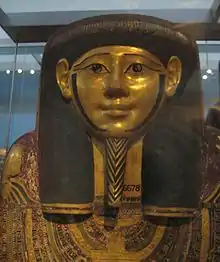
The upper part of the inner coffin of Hornedjitef.
Hornedjitef was an ancient Egyptian priest in the Temple of Amun at Karnak during the reign of Ptolemy III (246–222 BC). He is known from his elaborate coffins, mummy mask and mummy, dating from the Early Ptolemaic Period (around 220 BC) and excavated from Asasif, Thebes, Egypt, which are all held in the British Museum.[1][2][3] These related objects were chosen as the first of the hundred objects selected by British Museum Director Neil MacGregor in the 2010 BBC Radio 4 series A History of the World in 100 Objects.[4]
Along with his coffins, mummy-case, mummy-mask and mummy, Hornedjitef's tomb contained items such as a papyrus Book of the Dead[5] and a painted wooden figure of Ptah-Sokar-Osiris.[6]
Reading
- Mack, J. (ed.), Masks: the art of expression London: The British Museum Press, 1994
- Strudwick, Nigel, Masterpieces of Ancient Egypt, London: British Museum Publications, 2006
- Walker, S. and Bierbrier, M., Ancient faces: mummy portraits London: The British Museum Press, 1997
References
- ↑ "Outer coffin of the priest Hornedjitef". British Museum. Archived from the original on 2010-07-06. Retrieved 2010-06-09.
- ↑ "Mummy of Hornedjitef › The British Museum". Britishmuseum.org. Archived from the original on 2010-01-23. Retrieved 2010-06-09.
- ↑ "Mummy mask of Hornedjitef". British Museum. Archived from the original on 2010-03-10. Retrieved 2010-06-09.
- ↑ John Taylor, Curator, British Museum. "A History of the World - Object: Mummy of Hornedjitef". BBC. Retrieved 2010-06-09.
{{cite web}}: CS1 maint: multiple names: authors list (link) - ↑ "Search object details". British Museum. Retrieved 2010-06-09.
- ↑ "Painted wooden figure of Ptah-Sokar-Osiris". British Museum. Archived from the original on 2010-07-06. Retrieved 2010-06-09.
External links
- Outer coffin of Hornedjitef in the British Museum
- Inner coffin and mummy of Hornedjitef in the British Museum
- Mummy mask of Hornedjitef in the British Museum
- Painted wooden figure of Ptah-Sokar-Osiris from the burial of Hornedjitef. British Museum
- BBC Radio 4 A History of the World in 100 Objects website page on Hornedjitef
This article is about an item held in the British Museum. The object reference is The burial of Hornedjitef.
This article is issued from Wikipedia. The text is licensed under Creative Commons - Attribution - Sharealike. Additional terms may apply for the media files.